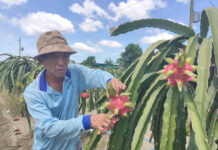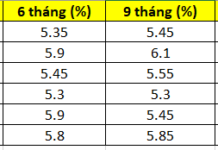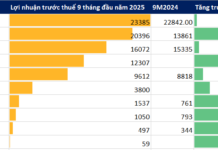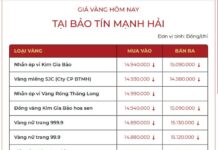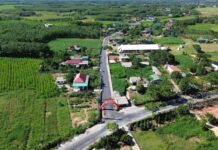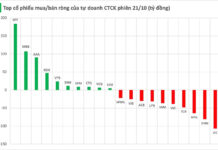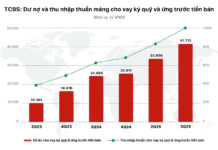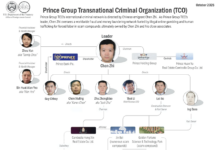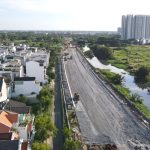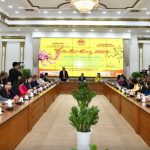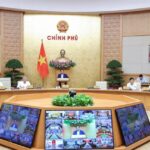According to the report on the 10-year implementation of Directive 40-CT/TW, issued on November 22, 2014, by the Secretariat of the Communist Party of Vietnam on enhancing the Party’s leadership in social policy credit (hereinafter referred to as Directive 40), the Ho Chi Minh City branch of the Vietnam Bank for Social Policies is implementing eight major social policy credit programs in the area. Among these, four programs are funded by local capital.
Efficient use of capital with low overdue debt
Total lending from the beginning of 2015 to the end of April 2024 reached VND 24,291 billion, with nearly 560,000 turns of poor and near-poor households and other policy beneficiaries being provided loans. The debt collection volume reached VND 15,365 billion, equivalent to 63.3% of the lending volume.
As of the end of April 2024, the total outstanding balance of the social policy credit programs reached VND 11,058 billion, an increase of VND 8,834 billion compared to 2014. There were 220,526 poor households and other policy beneficiaries with outstanding loans. On average, each household had an outstanding balance of VND 57.9 million, an increase of VND 40.7 million compared to 2014. The poor and other policy beneficiaries with a demand for and eligibility to borrow were provided access to products and services offered by the Vietnam Bank for Social Policies.
One of the notable factors in social policy credit activities is the efficiency of the capital. Ho Chi Minh City has always paid attention to and focused on consolidating and improving the quality of social policy credit activities. The city regularly directs the Ho Chi Minh City branch of the Vietnam Bank for Social Policies to coordinate with the city’s departments, Party committees, local authorities, and four social organizations (the Women’s Union, the Farmers’ Union, the Veterans Association, and the Youth Union) to vigorously and synchronously implement measures to enhance the effectiveness and quality of social policy credit activities.
The units have focused on raising people’s awareness of responsible borrowing and repayment, creating consensus and determination among authorities and organizations to improve the quality of social policy credit in the entire city. As of the end of April 2024, the total overdue debt of the social policy credit programs was VND 46.9 billion, accounting for 0.42% of the total outstanding balance. The overdue debt ratio decreased from 1.52% to 0.42% (-1.1%) compared to 2014.

Bank staff assisting borrowers during loan disbursement. |
Social policy credit is identified as a channel to provide additional resources for sustainable poverty reduction, contributing to promoting equality and fairness in society. The chairpersons of People’s Committees of wards, communes, and towns (who are also members of the Board of Representatives of the Board of Directors of the Vietnam Bank for Social Policies at the district level) are responsible for strengthening the review and confirmation of eligible borrowers so that the bank can disburse loans accordingly, ensuring compliance with regulations. Efforts are made to ensure that eligible borrowers with a demand for loans under these programs have access to social policy credit in the area.
The unique capital sources and lending methods of the Vietnam Bank for Social Policies have facilitated households in need of capital. Through their participation in savings and borrowing groups, many poor and near-poor households have gained access to effective production and business practices, as well as efficient utilization of borrowed capital…
Bright spots from business models
At the same time, the social policy credit capital of the Ho Chi Minh City branch of the Vietnam Bank for Social Policies has contributed to the development of production industries, the shift in crop and livestock structure, job creation for laborers, and the improvement of poor households’ livelihoods. Social policy credit capital also serves as a foundation for effectively implementing environmental protection programs and other economic, cultural, and social programs.

Ho Chi Minh City branch of the Vietnam Bank for Social Policies supporting youth in startup loans |
The effective integration of lending and guidance on livelihood improvement, along with the transfer of scientific and technical knowledge, has been facilitated by socio-political organizations. Various successful models and projects from the past years include beef cattle farming in Cu Chi district, goat farming in Binh Chanh district, apricot planting in Thu Duc city, clean vegetable growing cooperatives in District 12, Cu Chi, Hoc Mon, and Binh Chanh districts, aquaculture and salt production in Can Gio district, and traditional garment sewing cooperatives of the Cham ethnic community in Phu Nhuan district…
“These models have contributed to increasing the income and improving the lives of the poor, enhancing their social status, and gradually integrating them into the market mechanism. Especially, they help curb the situation of loan sharks and high-interest lending to poor households and other policy beneficiaries,” said the representative of the Ho Chi Minh City branch of the Vietnam Bank for Social Policies.
|
Meeting the capital needs of the poor In recent years, the Ho Chi Minh City Party Committee has directed Party committees, authorities, Fatherland Front committees, and socio-political organizations at all levels in the area to continue propagating and educating on the contents of Directive 40, Conclusion No. 06-KL/TW dated June 10, 2021, of the Secretariat of the Communist Party of Vietnam on continuing to implement Directive 40 (hereinafter referred to as Conclusion 06), and other directives of the City Party Committee and the City People’s Committee on enhancing the Party’s leadership in social policy credit. The Ho Chi Minh City Party Committee has directed the concentration of financial resources to meet the capital needs of the poor and other policy beneficiaries in the area. The report on the 10-year implementation of Directive 40 of the Secretariat on enhancing the Party’s leadership in social policy credit in Ho Chi Minh City has highlighted the outstanding results in social policy credit activities. This is one of the regular and key tasks in implementing the economic and social development plan for the years 2021 – 2025. |
Thai Phuong – Photos: Phuong Vy
2023 Remittances Surpass Half of Ho Chi Minh City’s Budget Revenue
As part of the Homeland Spring 2024 program in Ho Chi Minh City, this morning (2/2), the overseas Vietnamese delegation had a tour of the City Hall and met with city leaders.





